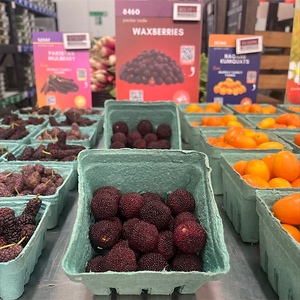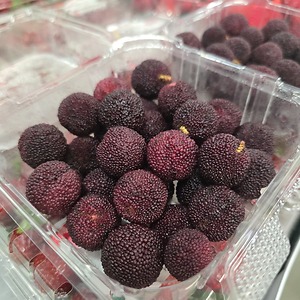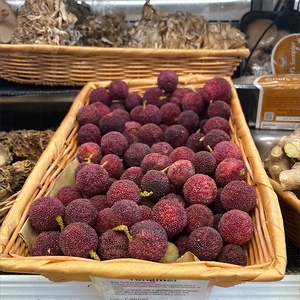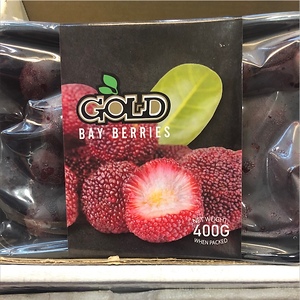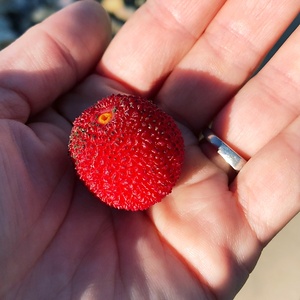


Waxberries
Estimated Inventory, lb : 0
This item was last sold on : 06/27/24
Description/Taste
Waxberries are small to medium-sized fruits, averaging 1 to 3 centimeters in diameter, and have a round to oval shape. The fruit has a distinct texture, covered in semi-rough bumps, crevices, and nodes. The thick skin also ranges in color from red to dark purple, sometimes white, depending on the specific variety, and has a chewy consistency. Underneath the surface, the flesh is soft, succulent, and aqueous, showcasing a ruby ring just below the skin, lightening to a cream-colored hue in the center. The flesh also encases a hard seed that is inedible and should be discarded before consumption. Waxberries have edible skin and flesh, creating a sweet-tart flavor with floral, herbal, and fruity nuances reminiscent of strawberries, pomegranates, and raspberries.
Seasons/Availability
Waxberries are only available for a few weeks in the late spring through early summer.
Current Facts
Waxberries, botanically classified as Myrica rubra, are an unusual fruit belonging to the Myricaceae family. The fruits grow on evergreen trees reaching 10 to 20 meters in height and are native to Asia, where the fruits have been cultivated for centuries as a medicinal and culinary ingredient. Waxberries have also been introduced to regions worldwide, acquiring several names, including Yangmei, Chinese Bayberry, Red Bayberry, and Yamamomo. In the United States, Waxberries are prohibited from being imported fresh due to the risk of introducing invasive insects, but seeds have been introduced and planted in California for cultivation. Waxberries are a seasonal delicacy, only available fresh for 3 to 5 weeks each year. The fruits are widely valued throughout Asia for their texture and flavor, and in other regions worldwide, they are increasing in popularity as a superfruit with a high vitamin and mineral content. Waxberries have a fruity and floral flavor savored for fresh and cooked preparations. The fruits are also sold in powdered form, juices, and purees.
Nutritional Value
Waxberries are a source of vitamin C to strengthen the immune system, vitamin E to protect the cells against free radical damage, and other antioxidants to reduce inflammation. The fruits also provide potassium to balance fluid levels within the body, magnesium to regulate nerve functioning, calcium and phosphorus to build strong bones and teeth, and contain other nutrients, including iron, thiamine, riboflavin, and carotene. In China, Waxberries are believed to assist in anti-aging and stimulate the digestive tract.
Applications
Waxberries have a sweet-tart, fruity, and floral flavor suited for fresh and cooked preparations. The fruits should be washed thoroughly as their bumpy, creviced surface often holds particles of dirt and insects. Waxberries can be cleaned by soaking in salt water and gently stirring to remove impurities. Once cleaned, Waxberries can be consumed out of hand, discarding the pit, or they can be sprinkled with salt. Waxberries can also be tossed into salads, blended into juices and smoothies, or steeped into a tea. In addition to fresh preparations, Waxberries can be simmered into jams, jellies, preserves, and syrups, baked into pies, tarts, and cobblers, poached in sugar water, and served chilled or cooked into sauces. The fruits can also be incorporated into various soups and stews or ground into a paste for deserts. It’s important to note that the juice from Waxberries can stain, so care should be taken to avoid permanent markings. Commercially, Waxberries are dried and sold as a chewy snack, fermented into liquors, or preserved in jars. Waxberries pair well with fruits such as apricots, pears, coconut, citrus, pineapple, lychees, and bananas, herbs including basil, cilantro, lavender, and mint, spices such as nutmeg, cinnamon, and ginger, rose, orange blossom, and lemongrass. Whole, unwashed Waxberries are highly perishable and will only keep for a couple of days when stored in the refrigerator.
Ethnic/Cultural Info
In 2003, Waxberries were rebranded under the name Yumberry and were marketed to regions worldwide, including Australia, the United States, and Europe. The rebranding was spearheaded by Charles Stenftenagel, a garden products importer from Indiana. Stenftenagel visited Shanghai and met with his friend who commercially bottled Waxberry juice. He noticed that the sound of Yangmei, the name for Waxberry in China, sounded similar to “yummy” and created Yumberry as a new marketing name. Stenftenagel hoped rebranding Waxberries would appeal to a broader untapped audience outside of Asia, and the fruit juice was promoted as a superfood for its high vitamin and mineral content. Over time, Yumberries were featured in several commercial products, including powders and juices. Most of the Yumberries used for the commercial products were grown in China and Southeast Asia, but small-batch fruits were also produced for novelty items. Notable Yumberry products include a Yumberry hard seltzer created by the Oskar Blues Brewery in Colorado, a Yumberry and pomegranate flavored Lifewater by SoBe, and a GoodBelly Yumberry probiotic drink.
Geography/History
Waxberries are native to China and have been growing wild since ancient times. The fruits thrive in humid, tropical regions and have been cultivated for thousands of years as a medicinal and culinary fruit. Waxberries continue to be a seasonal delicacy produced throughout China, specifically in the southern Yangtze River Delta and are also grown as a landscape ornamental in Japan, regions of Southeast Asia, the Philippines, and Korea. Outside of Asia, Waxberries are occasionally found in tropical regions of Africa, Europe, and Australia. Waxberries were introduced into the United States in the late 19th and early 20th centuries through seeds and were planted in California and Florida. Today Waxberries are a rare fruit in the United States as the trees can only be grown from seed. Imported Waxberry fruit is banned due to the prevention of introducing unwanted, potentially harmful insects. There are a few select farms growing Waxberries in California, and some trees are found in home gardens.
Recipe Ideas
Recipes that include Waxberries. One







